| |
|
Hessett is a
fairly ordinary kind of village to the east of Bury St
Edmunds, but its church is one of the most important in
East Anglia for a number of reasons, which I think will
become obvious. Consider for one moment, if you will, the
extent to which the beliefs and practices of a religious
community affect the architecture of its buildings. Think
of a mosque, for instance. Often square, expressing the
democracy of Islam, but without any imagery of the human
figure, for such things are proscribed. Think of a
synagogue, focused towards the Holy Scriptures in the
Ark, but designed to enable the proclaiming of the Word,
and the way that early non-conformist chapels echo this
architecture of Judaism - indeed, those who built the
first free churches, like Ipswich's Unitarian Chapel,
actually called them synagogues.
The shape of a church, then, is no accident. A typical
Suffolk perpendicular church of the 15th century has wide
aisles, to enable liturgical processions, a chancel for
the celebration of Mass, places for other altars, niches
for devotional statues, a focus towards the Blessed
Sacrament in the east, a roof of angels to proclaim a
hymn of praise, a large nave for devotional and social
activities, and wall paintings of the Gospels and
hagiographies of Saints, of the catechism and teachings
of the Catholic Church. As Le Corbusier might have said
if he'd been around at the time, a medieval church is a
machine for making Catholicism happen.
No longer, of course. The radical and violent fracture in
popular religion in the middle years of the 16th century
gave birth to the Church of England, and the new church
inherited buildings that were quite unsuitable for the
new congregational protestant theology, a problem that
the Church of England has never entirely solved.
Over the centuries, the problem has been addressed in
different ways. The early reformers celebrated communion
at a table in the nave, for example, and blocked off the
chancel for other uses. Although this was challenged by
the Laudian party in the early part of the 17th century,
it was the way that many parishes reinvented their
buildings, and most were to stay like that until the
middle years of the 19th century. Some went further. A
pulpit placed halfway down the nave, or even at the back
of the church, meant that the seating could be arranged
so that it no longer focused towards the east, thus
breaking the link with Catholic (and Laudian)
sacramentalism. For several centuries, Anglican churches
focused on the pulpit rather than the altar.
With the coming to influence of the 19th century Oxford
Movement, all this underwent another dramatic change,
with the great majority of our medieval parish churches
having their interiors restored to their medieval
integrity, reinventing themselves as sacramental spaces.
This is the condition in which we find most of them
today, and some Anglican theologians are asking the
question that the Catholic Church asked itself at Vatican
II in the 1960s - is a 19th century liturgical space
really appropriate for the Church of the 21st century?
So, let us hasten at once to Hessett. The church sits
like a glowing jewel in its wide churchyard, right on the
main road through the village. It is pretty well perfect
if you are looking for a fine Suffolk exterior. An
extensive 15th century rebuilding enwraps the earlier
tower, which was crowned by the donor of the rebuilding,
John Bacon.The nave and aisles are deliciously decorated,
reminding one rather of the church at neighbouring
Rougham, although this is a smaller church, and the
aisles make it almost square. A dedicatory inscription on
the two storey vestry in the north east corner bids us
pray for the souls of John and Katherine Hoo, who donated
the chancel and paid for the trimmings to the aisles.
Their inscription has been damaged by protestant
reformers, who obviously did not believe in the efficacy
of prayers for the dead.
Although not comparable with that at Woolpit, the dressed
stone porch is a grand affair, and a bold statement. You
may find the south door locked, but if this is the case
then the priest's door into the chancel is usually open.
And in a way it is a good church to enter via the
chancel, because in this way St Ethelbert unfolds its
treasures slowly.You step into relative darkness - or, at
least, it seems so in comparison with the nave beyond the
rood screen. This is partly a result of the abundance of
dark wood, and in truth the chancel seems rather
overcrowded. The most striking objects in view are the
return stalls, which fill the two westerly corners of the
chancel. These are in the style of a college or school of
priests, with their backs to the rood screen, but then
'returning' around the walls to the east. They are fine,
and are certainly 15th or 16th century. But one of the
stalls, that to the north, is different to the others,
and seems slightly out of place. It is elaborately carved
with faces, birds and foliage. Mortlock thought that it
might have been intended for a private house. The stall
in front of it has heads on it that appear to be wearing
18th century wigs. The sanctuary is largely
Victorianised, with the east window by William Warrington
depicting saints. The south windows of the chancel depict
sumptuous scenes of the Adoration of the Shepherds and
Magi by the O'Connors. The memorial to Lionel Bacon, who
died in 1651, seems extraordinarily ornate for its date.
Is it possible that it was actually erected after the
Restoration, perhaps in the 1660s?
The chancel is
separated from the nave by the 15th century rood screen,
which is elegantly painted and gilt on the west side with
friezes of birds, the beautifully tracery intricately
carved above. The rood screen has been fitted with
attractive iron gates, presumably evidence of
Anglo-catholic enthusiasm here in the early 20th century,
and you step down through them into the light.
  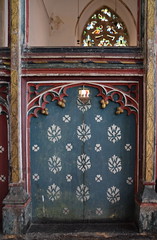
A first impression is
that you are entering a much older space than the one you
have left. There is an 18th century mustiness, enhanced
by the box pews that line the aisles. And, beyond, on
walls and in windows, are wonderful things.
The number of surviving wall paintings in England is a
tiny fraction of those which existed before the 15th and
16th centuries. All churches had them, and in profusion.
It isn't enough to say that they were a 'teaching aid' of
a church of illiterate peasants. In the main, they were
devotional, and that is why they were destroyed. However,
it is more complicated than that. Research in recent
years has indicated that many wall paintings were
destroyed before the Reformation, perhaps a century
before. In some churches, they have been punched through
with Perpendicular windows, which are clearly
pre-Reformation. In the decades after the Black Death,
there seems to have been a sea change in the liturgical
use of these buildings, a move away from an
individualistic, devotional usage to a corporate
liturgical one. There is a change of emphasis towards
more education and exegesis. This is the time that
pulpits and benches appear, long before protestantism was
on the agenda. What seems to happen is that many
buildings were intended now to be full of light, and
devotional wall paintings were either whitewashed, or
replaced with catechetical ones.
The decoration of the nave was the responsibility of the
people of the parish, not of the Priest. The wall
paintings of England can be divided into roughly three
groups. Roughly speaking, the development of wall
paintings over the later medieval period is in terms of
these three overlapping emphases.
Firstly, the hagiographies - stories of the Saints. These
might have had a local devotion, although some saints
were popular over a wide area, and most churches seem to
have supported a devotion to St Christopher right up
until the Reformation.
Secondly came those which illustrate incidents in the
life of Christ and his mother, the Blessed Virgin.
Although partly pedagogical, they were also enabling
tools, since private devotions often involved a
contemplation upon them, and at Mass the larger part of
those present would have been involved in private
devotions. These scriptural stories were as likely to
have been derived from apocryphal texts like the Gospel
of Pseudo-Matthew as from the actual Gospels themselves.
Lastly, there are catechetical wall paintings,
illustrating the teachings of the Catholic church. It
should not be assumed that these are dogmatic. Many are
simply artistic representations of stories, and others
are simplifications of theological ideas, as with the
seven deadly sins and the seven cardinal virtues. Some
warn against occasions of sin (gossiping, for example)
and generally wall paintings provided a local site for
discussion and exemplification.
To an extent, all the above is largely true of stained
glass, as well, with the caveat that stained glass was
more expensive, relied on local patronage, and often has
this patronage as a subtext, hence the large number of
heraldic devices and images of local worthies. But it was
also devotional, and so it was also destroyed.
So - what survives at Hessett? The wall paintings first.
Starting in the south east corner of the nave, we have
Suffolk's finest representation of St Barbara, presenting
a tower. St Barbara was very popular in medieval times,
because she was invoked against strikes by lightning and
sudden fires. This resulted from her legend, for her
father, on finding her to be a Christian, walled her up
in a tower until she repented. As a result, he was struck
by lightning, and reduced to ashes. She was also the
patron saint of the powerful building trade, and as such
her image graced their guild altars - perhaps that was
the case here.
Above the south door is another figure, often identified
as St Christopher, but I do not think that this can be
the case. St Christopher is found nowhere else in Suffolk
above a south door. The traditional iconography of this
mythical saint is not in place here, and it is hard to
see how this figure could ever have been interpreted as
such. I suspect it is a result of an early account
confusing the two images over the north and south doors,
and the mistake being repeated in later accounts.
In fact, digital enhancement seems to suggest that there
are two figures above the south door, overlapping each
other slightly. The figure on the right is barefoot, that
on the left is wearing a white gown. There appears to be
water under their feet, and so I think this is an image
of the Baptism of Christ. Perhaps it was once part of a
sequence.
The wall painting opposite, above the north door, is St
Christopher. Although it isn't as clear as himself at,
say, nearby Bradfield Combust, he bestrides the river in
the customary manner, staff in hand. The Christ child is
difficult to discern, but you can see the fish in the
water. Also in the water, and rather unusual, are two
figures. They are rendered rather crudely, almost like
gingerbread men. Could they be the donors of the north
aisle, John and Katherine Hoo in person?
  
Moving along the north
aisle, we come to the set of paintings for which Hessett
is justifiably famous. They are set one above the other
between two windows, at the point where might expect the
now-vanished screen to a chapel to have been. The upper
section was here first. It shows the seven deadly sins
(described wrongly in some text books as a tree of Jesse,
or ancestry of Christ). Two devils look on as, from the
mouth of hell, a great tree sprouts, ending in seven
images. Pride is at the top, and in pairs beneath are
Gluttony and Anger, Vanity and Envy, Avarice and Lust.
Some attempt has been made to erase the image for Lust,
which may simply be mid-16th century puritan prurience on
the part of some reformer here. This would suggest that
this catechetical tool was here right up until the
Reformation. If so, they were unsuccessful, because his
erect penis is still discernible.
The idea of 'Seven Deadly Sins' was anathema to the
reformers, because it is entirely unscriptural. Rather,
as a catechetical tool, it is a way of drawing together a
multitude of sins into a simplistic aide memoire.
This could then be used in confession, taking each of
them one at a time and examining ones conscience
accordingly. It should not be seen simply as a 'warning'
to ignorant peasants, for the evidence is that the
ordinary rural people of late medieval England were
theologically very articulate. Rather, it was a tool for
use, in contemplation and preparation for the sacrament
of reconciliation, which may well have ordinarily taken
place in the chapel here.
The wall painting beneath the Sins is even more
interesting. This is a very rare 'Christ of the Trades',
and dates from the early 15th century, about a hundred
years after the painting above. It is rather faded, and
takes a while to discern, and not all of it is decodable.
However, enough is there to be fascinating. The image of
the 'Christ of the Trades' is known throughout
Christendom, and contemporary versions with this can be
found in other parts of Europe. It shows the risen Christ
in the centre, and around him a vast array of the tools
and symbols of various trades. One theory is that it
depicts activities that should not take place on a
Sunday, a holy day of obligation to refrain from work,
and that these activities are wounding Christ anew.
Perhaps the most fascinating symbol, and the one that
everyone notices, is the playing card. It shows the six
of diamonds. Does it represent the makers of playing
cards? If so, it might suggest a Flemish influence. Or
could it be intended to represent something else?
Whatever, it is one of the earliest representations of a
playing card in England. Why is this here? It may very
well be that there was a trades gild chantry chapel at
the east end of the north aisle, and this painting was at
its entrance.
 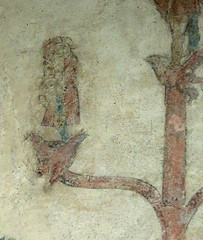 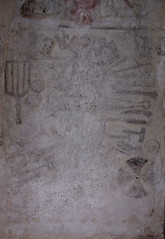
At the east end of the
north aisle now is the church's set of royal arms.
Cautley saw it in the vestry in the 1930s, and identified
it as a Queen Anne set. Now, with additions stripped
away, it is revealed as a Charles II set from the 1660s,
and a very fine one. It is fascinating to see it at such
close range. Usually, they are set above the south door
now, although they would originally have been placed
above the chancel arch, in full view of the congregation,
a gentle reminder of who was in charge.
And so to the glass, which on its own would be worth
coming to Hessett to see. Few Suffolk churches have such
an expanse, none have such a variety, or glass of such
quality and interest. It consists essentially of two
ranges, the life and Passion of Christ in the north aisle
(although some glass has been reset across the church),
and images and hagiographies of Saints in the south
aisle.
In the north aisle, the scourging of Christ stands out,
the wicked grins of the persecutors contrasting with the
pained nobility of the Christ figure. In the next window,
Christ rises from the dead, coming out of his tomb like
the corpses in the doom paintings at Stanningfield, North
Cove and Wenhaston. The Roman centurion sleeps soundly in
the foreground.
  
The most famous image
is in the east window of the south aisle. Apparently, it
shows a bishop holding the chain to a bag, with four
children playing at his feet. I say apparently, because
there is rather more going on here than meets the eye.
The reason that this image is so famous is that the small
child in the foreground is holding what appears to be a
golf club or hockey stick, and this would be the earliest
representation of such an object in all Europe. The whole
image has been said to represent St Nicholas, who was a
Bishop, and whose legends include a bag of gold and a
group of children.
Unfortunately, this is not the case. St Nicholas is never
symbolised by a bag of gold, and there are three children
in the St Nicholas legend, not four. In any case, the
hand in the picture is not holding the chain to a bag at
all, but a rosary, and the hockey stick is actually a
fuller's club, used for dyeing clothes, and the symbol of
St James the Less.
What has happened here is that the head of a Bishop has
been grafted on to the body of a figure which is probably
still in its original location. The three lights of this
window contained a set of the Holy Kinship. The light to
the north of the 'Bishop' contains two children playing
with what ae apparently toys, but when you look closely
you can see that one is holding a golden shell, and the
other a poisoned chalice. They are the infant St James
and St John, and the lost figure above them was their
mother, Mary Salome. This means that the figure with the
Bishop's head is actually Mary Cleophas, apocryphal
mother of St Simon, St Jude, St Philip and St James the
Less with his fullers club. The third light to the south,
of course, would have depicted the Blessed Virgin and
child, but she is lost to us.
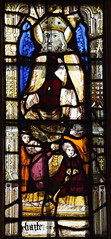  
Not only this, but
Hessett has some very good 19th Century glass which
complements and does not overly intrude. We have already
mentioned the glass by William Warrington and the
O'Connor Brothers in the chancel, and the best is beneath
the tower, the west window with scenes of the Passion in
a fully 15th Century style by Clayton & Bell.
If the windows and wall paintings were all there was,
then Hessett would be remarkable enough. But there is
something else, two things, actually, that elevate it
above all other Suffolk churches, and all the churches of
England. For St Ethelbert is the proud owner of two
unique survivals. At the back of the church is a chest,
no different from those you'll find in many a parish
church. In common with those, it has three separate
locks, the idea being that the Rector and two
Churchwardens would have a key each, and it would be
necessary for all three of them to be present for the
chest to be opened. It was used for storing parish
records and valuables.
At some point, one of the keys was lost. There is an old
story about the iconoclast William Dowsing turning up
here and demanding the chest be opened, but on account of
the missing key it couldn't be. Unfortunately, this story
isn't true, for Dowsing never recorded a visit Hessett.
The chest was eventually opened in the 19th century.
Inside were found two extraordinary pre-Reformation
survivals. These are a pyx cloth and a burse. The pyx
cloth was draped over the wooden canopy that enclosed the
blessed sacrament (one of England's four surviving
medieval pyxes is also in Suffolk, at Dennington) before
it was raised above the high altar. The burse was used to
contain the host before consecration at the Mass. They
are England's only surviving examples, and they're both
here. Or, more precisely they aren't, for both have been
purloined by the British Museum, the kind of theft that
no locked church can prevent.
But there are life-size photos of both either side of the
tower arch. The burse is basically an envelope, and
features the Veronica face of Christ on one side with the
four evangelistic symbols in each corner. On the other is
an Agnus Dei, the Lamb of God. The survival of both is
extraordinary. It is one thing to explore the furnishings
of lost Catholic England, quite another to come face to
face with articles that were actually used in the
liturgy.
In front of the pictures stands the font, a relatively
good one of the early 15th century, though rather less
exciting than everything going on around it. The
dedicatory inscription survives, to a pair of Hoos of an
earlier generation than the ones on the vestry.Turning
east again, the ranks of simple 15th century benches are
all of a piece with their church. They have survived the
violent transitions of the centuries, and have seated
generation after generation of Hessett people. They were
new here when this church was alive with coloured light,
with the hundreds of candles flickering on the rood beam,
the processions, the festivals, and the people's lives
totally integrated with the liturgy of the seasons. For
the people of Catholic England, their religion was as
much a part of them as the air they breathed. They little
knew how soon it would all come to an end.
And so, there it is - one of the most fascinating and
satisfactory of all East Anglia's churches. And yet, not
many people know about it. We are only three miles from
the brown-signed honeypot of Woolpit, where a constant
stream of visitors come and go. I've visited Hessett many
times, and never once encountered another visitor. Still,
there you are, I suppose. Perhaps some places are better
kept secret. But come here if you can, for here is a
medieval worship space with much surviving evidence of
what it was actually meant to be, and meant to do.
Simon
Knott, October 2019
Follow these journeys as they happen at Last Of England
Twitter.
  
  
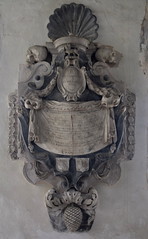    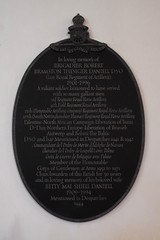
   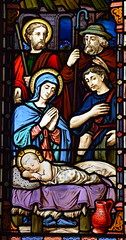 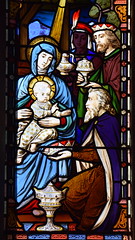
     
 

| |
| |
|
|
|
|
|
|
|
| |
|
|
|
|
|
|
|
|
The Churches of East
Anglia websites are
non-profit-making, in fact they
are run at a loss. But if you
enjoy using them and find them
useful, a small contribution
towards the costs of web space,
train fares and the like would be
most gratefully received. You can
donate via Paypal.
|
|
|
|
|
|
|
|
|
|
|
|
|
|
|
|
|
|
|
|
|
|
|
|
| |
|
|
|
|
|
|
|
|
|
|
|
|
|
|
|
|
|

